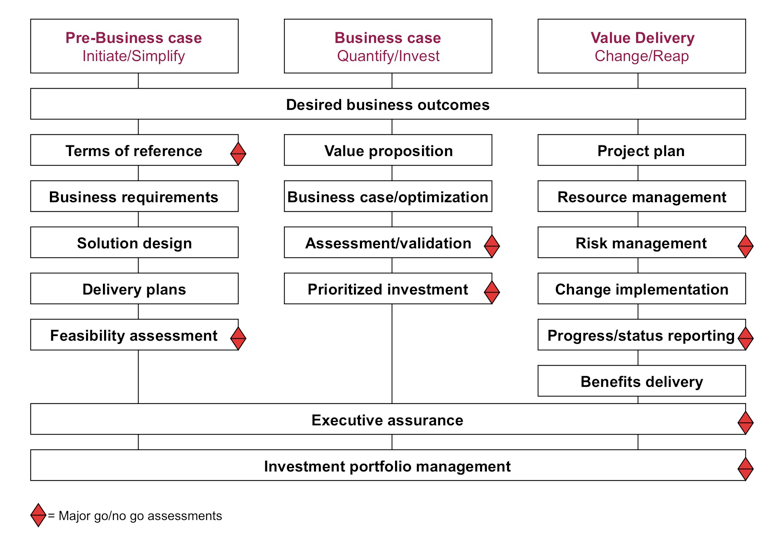For the past 20 years, we have been improving how projects are delivered, so as to reduce failure rates. While this is both necessary and laudable, improving project delivery processes is not sufficient to solve the problem of “Why are we not getting the business value from projects?”
Instead, we need to focus on the investment and business results — on successfully delivering desired business outcomes, the benefits and value — if we are to achieve real improvement in business performance from our projects.
There are 15 questions, which if you ask them at the right time at each key step in the three key stages, will measurably improve your ability to increase project investment value from all your projects.
The 3 stages in project value delivery:
First, you need to understand the three stages of project value delivery:
- pre-business case
- business case
- value delivery stage
Each stage has its own tasks and questions to be answered.

Note that in this model, the business case is positioned after requirements definition, solution design and project planning. This positioning is important as having the business case too early in the value delivery process leads to work duplication, poor estimates, poor decisions, and poor results.
The pre-business case stage
This is the stage where the seeds of success or failure are sown and most of the costs are locked in. The subsequent two stages merely act out what is defined in this too often neglected stage.
Pre-business case analysis is often skimped on by the business or conducted with the least controls, direction and attention, and the least understood measures of success. Yet, this is the stage where the most analysis and investigation work should be done.
Full and strong business leadership is needed to ensure that the:
- right business outcomes are defined — where you want to be in the business after the end of the project;
- right requirements are defined — how you want to do business, compete and make money in the future in step-by-step business terms;
- optimal solution is selected or designed — to generate the optimum value for the least practical cost.
This stage is when the business needs to take hold of the reins and both steer and drive the project to define what it wants. (And not just abdicate the project to the ‘specialists’ or succumb to the many myths that pervade this stage.)
Here are five major questions you need to ask and some key issues to deal with in this critical stage:
- Is this project/idea/concept worthwhile?
- Have we fully defined in detail how we want to work in the future?
- On what basis have we selected this solution?
- How are we planning to deliver the agreed solution, outcomes, and benefits?
- Is delivering the proposed project, solution, outcomes and benefits feasible?
You will know that you are ready to move onto the next stage — that of defining the business case when you have:
- no ‘unknown unknowns’ — that all of the business, project, and delivery dimensions have been thoroughly thought through and defined and all unknowns that can be resolved, have been resolved;
- assumptions that are known, clear, justifiable, and trackable , so you can identify and assess the impacts of any future changes or errors and are not ‘flying blind’;
- clear understanding of the resultant size, scale, and complexity of your initiative compared to your organisation’s capability to successfully deliver it. (Too many organisations take on projects that are beyond their capability to deliver and squander millions in an attempt to deliver ‘something’);
- defined a complete, detailed (process-based) definition of your current state — the state from which you have to change: the state where your staff live and work today;
- defined a set of simplified processes (together with their information needs and process logic) redesigned to meet your strategic intent and to deliver step-change improvements in business performance;
- defined your desired business outcomes the new processes will deliver — the business end states to be achieved;
- defined Master Change Plans for the major changes required to achieve the desired business outcomes — allowing you to estimate the nature and cost of the delivery workload;
- selected a solution designed and/or selected based on your process-based specification;
- planned the full delivery of the business outcomes including a list of easy to implement changes that will deliver immediate benefits; and,
- validated the feasibility of the project in all of its dimensions by those with the authority to sign it off.
If for any reason your project is not approved at this point, you should still be able to implement the immediate changes and any other possible improvements through business-as-usual so as to realise some real business value from the Pre-Business Case stage of the project — i.e. not all value will be lost.
The business case stage
The business case should be (but too often is not) the central document of the whole project as it spells out what the project is going to enable, deliver and support in business outcomes, benefits and value terms. It also sets out the constraints (funds, resources, timeframes), and means (approach, accountabilities and controls).
The business case should not be a ‘dash for cash’; rather it should document a two-way contract between the project sponsor and the organisation that says: “I, the Sponsor, will deliver these business outcomes, benefits and value if you, the organisation, provide me with these resources — people, funds, etc.”
In view of its criticality, the business case needs to be complete, correct and comprehensive — accurately reflecting all aspects of the investment. It is also a selling document, so it needs to be thoroughly validated — not just ‘checked’ or ‘reviewed’. It needs to be pulled apart, scrutinised and analysed to ensure each and every aspect of the project is thought through, all relevant options have been thoroughly explored and that the resultant recommendations are optimal. Then, and only then, should the business case be submitted for prioritisation and approval.
There are three key questions to be asked at the business case stage:
- Is the project’s ‘value equation’ clear and correct?
- Is the business case valid?
- Is this project a priority NOW?
You will know that you have completed this stage and your project is ready to move onto the next stage when you have:
- an agreed, clear, measurable value equation that is the goal of everyone to realise;
- a thoroughly validated business case and project to ensure any weaknesses and gaps have been identified and rectified before the additional costs of development and delivery are incurred;
- a project that is deemed to be of sufficient value as to be a priority for implementation;
- a project team and a governance team seen to be able to deliver the project’s value as promised in the business case; and,
- all relevant stakeholders supporting the total delivery of the project.
The value delivery stage
This is the stage when you as an executive, need to step up — not step back.
Even if you have fully defined your needs, requirements, solution and business case to the detail required, you still have to ensure the development and delivery of the solution remains aligned with both your specification and intent. You have to ‘steer’ the project. Documents can make known your specifications but only rarely do they capture your full intent. And it is the failure to meet your (at times unspoken) intent that often leads to the most angst come delivery day.
Also, the project needs your support to succeed. Because of your position, authority and business knowledge you can often resolve issues in 5 minutes that would take the project manager 5 weeks to resolve. The project also needs you to provide the right resources, decisions, guidance, control and enthusiastic commitment.
There are three key questions to be during the value delivery stage:
- How can I best control the project?
- How can I enable the project’s success?
- Are we managing the risks?
- Are we managing the change successfully?
- How can I track how we are going?
- How do I ensure we get the benefits?
- How do I know if we have been successful?
How do you know you have finished? You know you have finished your project when:
- it has delivered all of its project outcomes and the agreed business benefits to be delivered by the project;
- the lessons learned from the project have been captured and forwarded to those accountable for promulgating the lessons;
- the business users have fully accepted the outcomes;
- the solution is working effectively and reliably; and,
- the project team can be fully disbanded.
However, the governance team’s work must continue. They are not finished until they have:
- fully realised the desired business outcomes;
- fully realised the associated business benefits;
- tracked and measured the value of the benefits and taken action on any variances;
- fully integrated the project outcomes/deliverables into business-as-usual;
- ensured the governance lessons learned have been captured and promulgated to other governance teams; and,
- gained the investment committee’s agreement the investment has met its promise.
Ask the 15 questions at the right stage and you will automatically switch your focus from delivery cost to investment value realisation — and achieve the results you want from projects.





